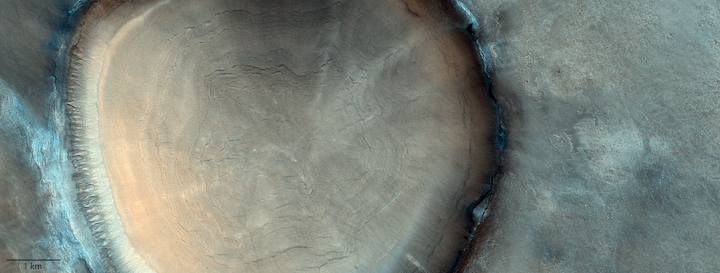30.01.2022

This image from CaSSIS aboard the ExoMars TGO reveals an impact crater on Mars that looks like a tree stump. (Image credit: ESA/Roscosmos/CaSSIS, CC BY-SA 3.0 IGO
A Mars probe has snapped a peculiar image of the Red Planet's surface that looks like a giant tree stump, rings and all.
The ExoMars Trace Gas Orbiter (TGO), a joint mission by the European Space Agency (ESA) and Russia's space agency Roscosmos, studies Mars from above, circling the planet and collecting data about its sparse atmosphere. But this orbital vantage point also allows TGO to see Mars from above, snapping images with its Color and Stereo Surface Imaging System (CaSSIS) camera.
In a newly revealed image the orbiter snapped on June 13, 2021 in the northern plains of Acidalia Planitia, a strange surface feature is turning heads. From above, it looks like a giant tree stump, with concentric rings marking its years of age. However, it's not an alien tree stump, but rather an ice-rich impact crater.
(Acidalia Planitia also happens to be the landing site for the human Mars mission depicted in the sci-fi novel and movie "The Martian.")
While the crater's rings don't spell its age, the patterns within the crater can help researchers to better understand what makes up its structure and what has happened on Mars throughout its history.
One thing scientists think they can tell so far about the crater is that it is chock-full of deposits rich in water ice; deposits that were laid much earlier in the planet's history, according to a statement from ESA. They think that these deposits in the impact crater settled there when they did because of how the planet's tilt, or spin axis, has changed over time. A planet's tilt, as we see on Earth, cause seasonal changes, and Mars' tilt has changed quite dramatically over time compared to Earth's tilt.
During this earlier time on Mars, the planet's tilt, or spin axis, would have allowed water-ice deposits to form at lower latitudes than would be possible today, according to the statement.
In fact, the crater's "rings" and noticeable cracks are likely due to environmental changes over time. Researchers think that these features are the result of changing seasons and temperatures, causing the material in the crater to expand and contract with the heat and cold.
TGO arrived at Mars in 2016 as part of ESA's ExoMars missions to study the planet from its orbit and its surface. The mission continues to deliver images like this as well as data regarding Mars' atmosphere, geology, surface, history and more.
Quelle: SC

